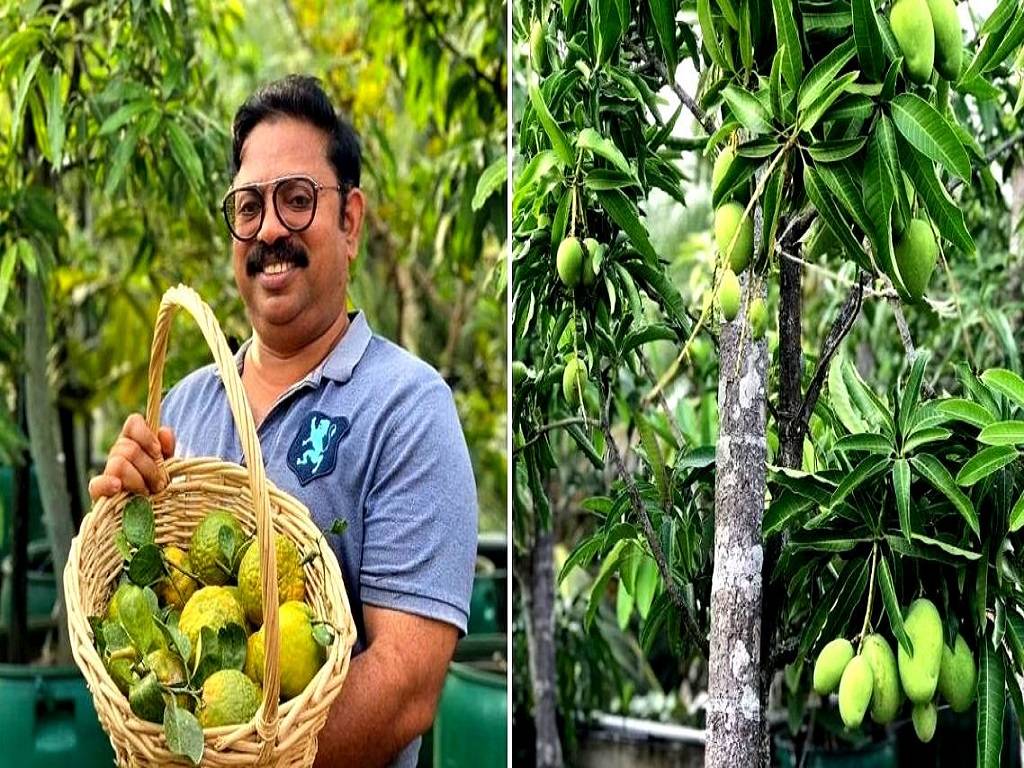
Abdurazak, a native of Tirur in Kerala, wanted to plant fruit trees when he returned from Dubai in 2018. However, these trees grow better on land, and he realized that his terrace might not be enough.
He was aware that, like other home gardeners, he could grow them in grow bags.
"However, this actually stunts the growth of the trees, making them unproductive in many cases. So I needed a more practical and effective way to grow bags," Abdurazak stated.
So he decided to grow the trees in plastic drums instead. He now has a fruit orchard of 250 trees, 135 of which grow in drums.
Finding an Alternative to Grow Bags
Abdurazak returned to his hometown Kerala after spending nearly 30 years in Dubai. He claims he has always enjoyed nurturing trees, particularly fruit-bearing ones, and that he would plant many in his house whenever he returned home from work.
"However, when I planted the trees on the land, they didn't grow well owing to a lack of sunlight. So I decided to try planting them on the terrace," said Abdurazak, who used to work for a wholesale fruit and vegetable company in Dubai.
He claimed that his three decades of experience working with fruits has helped him understand the scope of cultivating different varieties all over the world. Even the idea of growing them on plastic drums was inspired from a fruit farm in Thailand, he said.
"I had the opportunity to interact with farmers and agencies from over 56 nations while working in the fruit wholesale sector. One of the Thai fruit farms that used to send us fruits had adopted this technique of growing fruits on plastic drums. They used to cultivate fruits in thousands of these plastic drums and reap high yields," the 50-year-old added.
"This technology was developed to reduce labor and fertilizer waste. When we plant these trees on the land, around 75% of the fertilizer is wasted since it travels underground with the water. This leaves just 25% to be absorbed. As a result, this method actually promotes tree development," he said.
Razak wanted to test the waters. So he decided to start by planting a few trees in plastic buckets. "I took paint buckets, filled them with soil, and planted them to see if the method worked in our climate conditions. It did, so I went out and bought used plastic drums from scrap shops and began planting trees in them," he said, adding that each drum costs around Rs.700.
"Unused and new plastic drums are twice as expensive," stated Abdu. "I would recommend this method only if you are passionate about growing fruit trees and are not growing them for commercial purposes. If you plant fruit trees in this manner, you could get yield sufficient for you and your family," he added, adding that it is thus critical to choose varieties of fruit trees that provide fruit throughout the year.
Razak’s fruit orchard currently houses around 250 fruit trees from different parts of India, as well as from countries such as Thailand, Pakistan, Brazil and Australia.
“I mostly buy foreign varieties online. There is a Kolkata-based agency through which I source different varieties of mangoes,” he added.
He owns over 70 foreign varieties of mangoes, as well as various guava and jackfruit varieties.
He claimed that fruit trees cultivated in drums yield far more quickly than those grown on land. "If it takes five years for trees to grow on land, it only takes two years for trees to grow in drums. Even with a higher yield, the number of fruits produced in drums will be less."
“If you get 100 mangoes from a tree growing on land, you will only get 25 or 50 from the ones planted in drums. But you could utilize the space consumed by a big mango tree to grow around 10 to 15 trees in drums, that too of different varieties,” he explained. “Therefore, it is important to plant trees that could yield fruits in all seasons.”
Trees grown on land do not need to be watered frequently, but those in plastic drums need to be watered at least twice a day, according to him. "I installed a drip irrigation system on the terrace and water them twice a day, once in the morning and once in the evening. Since they are on the terrace and exposed to the sun, they need more water than those on land, which are able to sustain even without water, as their roots have the capability to find water from the soil,” he elaborated.
“I use a bioslurry made out of cow dung, neem cake, bone meal, jaggery, and sheema konna leaves (Gliricidia sepium). I mix this with water and spray it on these trees,” he said when asked about what fertilizer he uses.
Razak added that because the trees are kept in drums and on the terrace, it is vital to prune them on a regular basis to keep their size at an optimal level. "It's critical to maintain them at a maximum height of 7 to 8 feet," he added.
How to grow fruit trees on drums
-
Use plastic drums with capacities ranging from 70 to 130 liters, and choose them depending on the size of the fruit tree.
-
Make at least three 8 mm to 16 mm holes at a distance of 3 inches from the drum's bottom. The holes allow water to escape.
-
Fill 3/4 of the drum with a potting mixture of soil, biofertilizer, and coco peat, and then plant the tree.
-
Water them at least once a day or once in two days.
-
It is suggested to spray fertilizer once a month or once in two months.
-
Prune them on a regular basis and train them to flourish at their optimum.
















